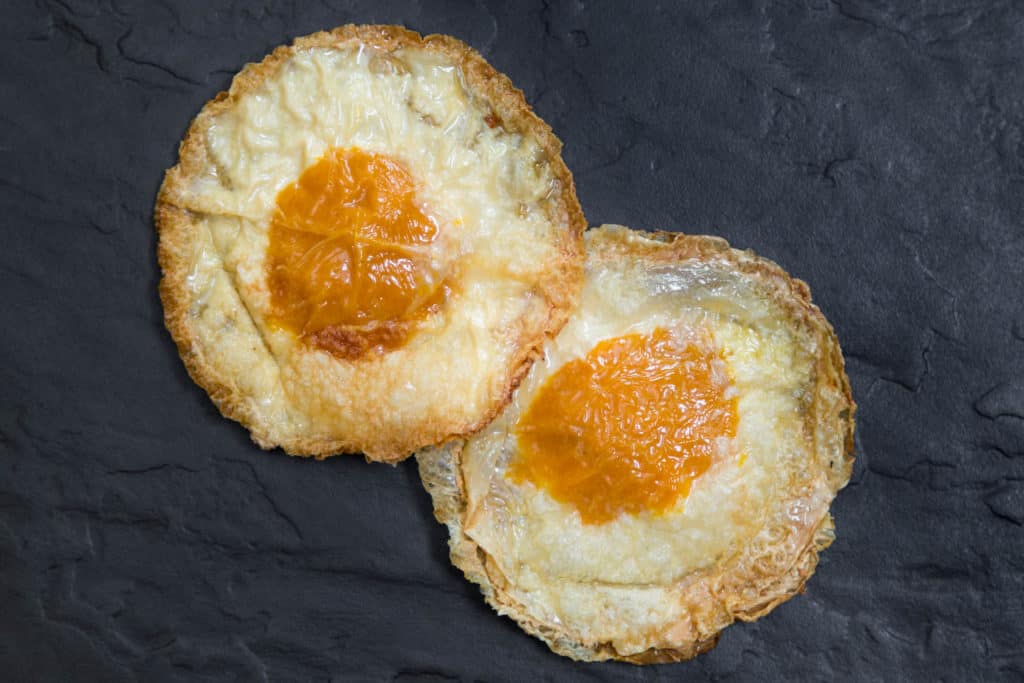My first encounter of a vegan fried egg recipe was in 2012, printed in The Vegg Cookbook. Following instructions on spherification of a vegan egg yolk (using the molecular gastronomy technique made popular by Ferran Adrià), author Rocky Shepheard continues with instructions for the "world's best (& most realistic) vegan fried egg." The title he gave to that recipe is still veritably accurate and if you are interested in palate-rewarding culinary chemistry experiments I highly recommend purchasing the book.
The world's best vegan fried egg, however, is based on Western expectations of how a fried egg is cooked. That is to say minimally, enough to solidify only the white, with a very runny yolk. This is not the Thai way.

Bean curd sheets make it possible for vegan fried eggs to achieve the crispy texture appreciated in Thai style fried eggs
Western Versus Thai Style
Unlike their Western counterpart, Thai style fried eggs are expected to be crispy and browned. This is a result of the cooking method. Instead of a low heat pan fry, fried eggs in Thailand are born of sputtered high heat deep frying in a wok. The yolk is anticipated to be set.
With the use of bean curd sheets, called yuba in Japanese, it's easy to replicate the crispy texture of Thai style fried eggs. This is achieved by a two step cooking process. First the eggs are assembled and steamed. Second they are fried.
For this vegan fried egg recipe there are two different mixtures to prepare: the white and the yolk. The former includes blended tofu and rice flour. The yolk is made from rice flour and steamed pumpkin. When the eggs are steamed, the rice flour helps to thicken and solidify the mixtures. Additionally the steaming process softens the yuba so it binds to the mash inside.
Once the steaming process is complete, the eggs are solid and ready to fry up. They can also be frozen for future use.
Bean Curd Sheets / Yuba / Tofu P'i
When purchasing the bean curd sheets it's important to buy the correct type, which is the semi dried pliable variety (pictured below) called tofu-p'i in China. Do not use fresh or wholly dehydrated sheets for this recipe.
You can find these bean curd sheets in most well stocked Chinese grocers. Sometimes the frozen section should be your port of call, but there are also shelf stable varieties. Oftentimes the packaging will have the text "bean curd sheet" printed on the front, but not always.
When you open the package the sheets will unfold into massive circles or half circles.
📖 Recipe
Vegan Fried Eggs – Kai Dao Jay (ไข่ดาวเจ)
Ingredients
For the egg yolk
- 300 grams pumpkin
- 25 grams rice flour (3 tablespoons)
- ¾ teaspoon black salt
For the egg white
- 300 grams very firm tofu
- 25 grams rice flour (3 tablespoons)
- 3 tablespoons water
- 1 teaspoon thin soy sauce
- Packaged yuba (bean curd sheets)
- Vegetable oil
Instructions
- First make the yolk. Steam the pumpkin over high heat until fork tender. Allow to cool completely. Blend (or use a food processor, or mash) to a puree with the rice flour and black salt. The texture will be like chalky mashed potatoes.
- Decant all of the yolk to a bowl and rinse out the container. Make the egg white mixture by blending the tofu, rice flour, soy sauce, and water together. Scoop mixture out into a second bowl.
- Find a small bowl that’s somewhere between 4-5 inches in diameter. Use this as a template for cutting circles out of yuba. Cut 30 circles to start. You may need more.
- Set your steaming apparatus up by lining each tier with a plate that fits. Bring to a rapid boil.
- Place half of the yuba circles on your countertop and add a tablespoon of egg white to each sheet. Spread to about ½ centimeter of the edges. Add a heaped ½ tablespoon of yolk to the centre. Place a second sheet of yuba on top and press around the whites to seal to the edges. It’s okay if a little of the white oozes out. Do not press the yolk at all.
- Place the eggs on the plates in the steamer, being careful to not overlap them too much. Steam for ten minutes. Leave to cool for at least 15 minutes before frying.
- When ready to fry, add about ¼ cup vegetable oil to your wok. Aim for medium-high heat. Add one of the eggs and use a wok spatula to toss some of the oil over the top of the egg while the bottom and edges crisp and brown. Alternatively flip the egg to cook for a few seconds. This should take 30 seconds to a minute. Remove to kitchen roll to drain.
Notes
- Thin soy sauce refers to basic Thai soy sauce.
- You do not want to use fresh yuba (soy milk skin) for this recipe. Instead, look for packaged bean curd sheets with Chinese text on the packaging. The sheets must be flexible and not the dried kind that are brittle. This is not the same as tofu skin.
- Yuba can dry out fairly quickly so keep any pieces you aren’t using in a sealed container.
- You can dip the ½ tablespoon measure in a little bit of oil before scooping the yolk that it releases easily in a uniform shape when you drop it onto the white.